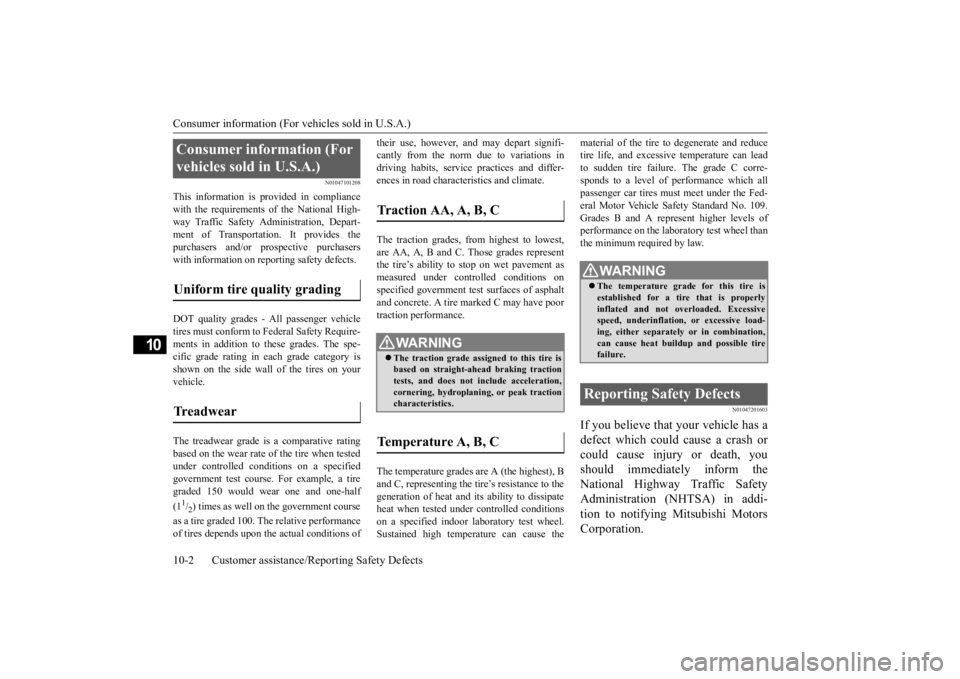climate control MITSUBISHI MIRAGE G4 2020 Owner's Manual (in English)
[x] Cancel search | Manufacturer: MITSUBISHI, Model Year: 2020, Model line: MIRAGE G4, Model: MITSUBISHI MIRAGE G4 2020Pages: 253, PDF Size: 36.39 MB
Page 213 of 253

Tires 9-16 Vehicle care and maintenance
9
The treadwear grade is a comparative rating based on the wear rate of thetire when tested under controlled conditions on a specified government test course. For example, a tiregraded 150 would wear one and one- half (1
1/2) times as well on the gov-
ernment course as a tire graded 100. The relative performance of tires depends upon the actual conditionsof their use, however, and may depart significantly from the norm due to variations in driving habits, servicepractices and differences in road characteristic
s and climate.
The traction grades, from highest to lowest, are AA, A, B and C. Those grades represent the tire’s ability to stop on wet pavement as measured
under controlled conditions on speci- fied government test surfaces of asphalt and concrete. A tire marked C may have poor traction perfor-mance. The temperature grades are A (the highest), B and C, representing thetire’s resistance to the generation of heat and its ability to dissipate heat when tested under controlled condi-tions on a specified indoor laboratory test wheel. Sustained high tempera- ture can cause the material of the tireto degenerate and reduce tire life, and excessive temperature can lead to sudden tire failure. The grade C cor-responds to a level of performance which all passenger car tires must meet under the Federal Motor Vehi-cle Safety Standard No. 109. GradesB and A represent higher levels of performance on the laboratory test wheel than the minimum required bylaw.
N00939302037
Proper tire inflation pressure is essential for the safe and satisfactory operation of your vehicle. The wrongtire pressure will cause problems in three major areas:SafetyToo little pressure increases flex- ing in the tire and can cause tirefailure. Too much pressure can cause a tire to lose its ability to cushion shock.
Objects on the
road and potholes could then cause tire damage that may result in tire failure.Economy The wrong tire pressure can cause uneven wear patterns in the tiretread. These abnormal wear pat- terns will reduce the tread life, and the tire will have to be replacedsooner.Too little pressure also makes it harder for the tire to roll, and this uses up more fuel.
Treadwear, Traction and Temper- ature Grades Treadwear Tr a c t i o n
Temperature
Tire inflation pressures
BK0284300US.book 16 ページ 2019年5月23日 木曜日 午後12時22分
Page 237 of 253

Consumer information (For vehicles sold in U.S.A.) 10-2 Customer assistance/Re
porting Safety Defects
10
N01047101208
This information is provided in compliance with the requirements of the National High- way Traffic Safety Ad
ministration, Depart-
ment of Transportation. It provides the purchasers and/or prospective purchasers with information on repor
ting safety defects.
DOT quality grades - Al
l passenger vehicle
tires must conform to
Federal Safety Require-
ments in addition to these grades. The spe- cific grade rating in each grade category isshown on the side wall of the tires on your vehicle. The treadwear grade is a comparative rating based on the wear rate of
the tire when tested
under controlled conditions on a specifiedgovernment test course
. For example, a tire
graded 150 would wear one and one-half (11/2) times as well on the government course
as a tire graded 100.
The relative performance
of tires depends upon the actual conditions of
their use, however, and may depart signifi- cantly from the norm due to variations indriving habits, service practices and differ- ences in road characteristics and climate. The traction grades, from highest to lowest, are AA, A, B and C. Those grades represent the tire’s ability to
stop on wet pavement as
measured under controlled conditions on specified government te
st surfaces of asphalt
and concrete. A tire marked C may have poor traction performance. The temperature grades are A (the highest), B and C, representing the ti
re’s resistance to the
generation of heat and it
s ability to dissipate
heat when tested un
der controlled conditions
on a specified indoor
laboratory test wheel.
Sustained high temperature can cause the
material of the tire to
degenerate and reduce
tire life, and excessive temperature can leadto sudden tire failure. The grade C corre- sponds to a level of performance which all passenger car tires must meet under the Fed-eral Motor Vehicle Safety Standard No. 109. Grades B and A represent higher levels of performance on the labora
tory test wheel than
the minimum required by law.
N01047201603
If you believe that your vehicle has a defect which could cause a crash or could cause injury or death, you should immediately inform theNational Highway Traffic Safety Administration (NHTSA) in addi- tion to notifying Mitsubishi MotorsCorporation.
Consumer information (For vehicles sold in U.S.A.) Uniform tire quality grading Treadwear
Traction AA, A, B, C
WA R N I N G The traction grade assi
gned to this tire is
based on straight-ahead braking tractiontests, and does not include acceleration, cornering, hydroplani
ng, or peak traction
characteristics.
Temperature A, B, C
WA R N I N G The temperature grade for this tire is established for a tire that is properlyinflated and not overloaded. Excessive speed, underinflation
, or excessive load-
ing, either separately
or in combination,
can cause heat buildup and possible tire failure.
Reporting Safety Defects
BK0284300US.book 2 ページ 2019年5月23日 木曜日 午後12時22分